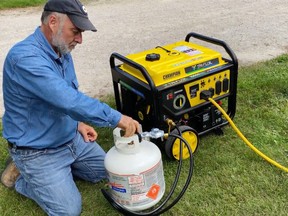
Reviews and recommendations are unbiased and products are independently selected. Postmedia may earn an affiliate commission from purchases made through links on this page.
Article content
q Have you written anything about how to adapt a gasoline generator to burn gasoline and propane?
TO I haven’t created any content on DIY retrofitting, but I have experiences with different generators that burn propane. The first was a unit I purchased where the retailer had added a propane regulator and a hose that fed the gasoline carburetor for dual fuel use. This arrangement works, but not well, especially in cold climates. That being said, different manufacturers are releasing factory-built dual and triple fuel models that, in my experience, perform quite well. I’ve spent the most time with Champion models that burn propane in addition to gasoline, or propane and natural gas. The natural gas option is especially attractive because it costs much less than propane, and a natural gas model can operate without refueling indefinitely during an extended outage if it is connected to your main natural gas power line. In my experience, Champion models start and run just as reliably on propane as they do on gasoline, although there is one thing to keep in mind.
Advertisement 2
Article content
Article content
Neither propane nor natural gas provide as much energy as gasoline, so you should expect somewhat lower power output when running on propane or natural gas compared to gasoline.
————

Refinish an antique dresser
q How should I proceed to renovate an old dresser owned by my great-grandfather? I think it needs sanding and oiling. The wood looks dry and old.
TO The thing about antiques is that even beneath an old, ugly finish there is something important to preserve. It’s called “patina” and it’s a kind of golden brown color that’s one of the reasons some antiques look so good. The thing about patina is that it is easily destroyed by sanding. Once you pass through it, it disappears.
There appears to be no old, dirty paint or varnish on your vanity, so consider scrubbing the surface with a fine synthetic steel wool. Vacuum up all the debris and then apply some oil. If I had to remove an ugly finish first, I would start with some type of safe paint stripper to soften the dirt and then use a sharp putty knife to scrape it off. Follow with light abrasion using synthetic abrasive wool to remove remnants of the previous finish, followed by cleaning the surface with a vacuum cleaner and bristle brush.
Advertisement 3
Article content
An oil finish is a great option for antiques. I prefer flat or satin finishes over glossy ones, as the duller look hides imperfections better. You might also consider a colored oil finish to add depth and richness. My favorite is the one made by Watco.
Apply oil to the surface, let it sit and soak, then wipe it off furiously before letting the surface dry completely. Repeat the process three or four times and your grandfather would be very pleased if he could see how you have cared for a family heirloom.
————
Ventilate an apartment
q How can I control mold growth during the winter in an apartment that does not have a heat recovery ventilator (HRV)?
TO:There are three things you can do that should make a big difference in reducing winter humidity levels and eliminating mold. First, open some windows a little and leave them open slowly all the time. Second, run the bathroom exhaust fan for several hours a day, and the same with the kitchen exhaust hood, if you have one. And finally, make sure the space under the front door is open and not blocked with a rug or door brush. Apartment ventilation systems are designed to direct air from hallways to individual units through the space under the door. If you block this space, there will be no adequate ventilation.
Steve Maxwell is a big fan of fresh air in Canadian homes. Visit him online at baileylineroadcom and learn from the over 2000 articles and videos he has online.
Article content
